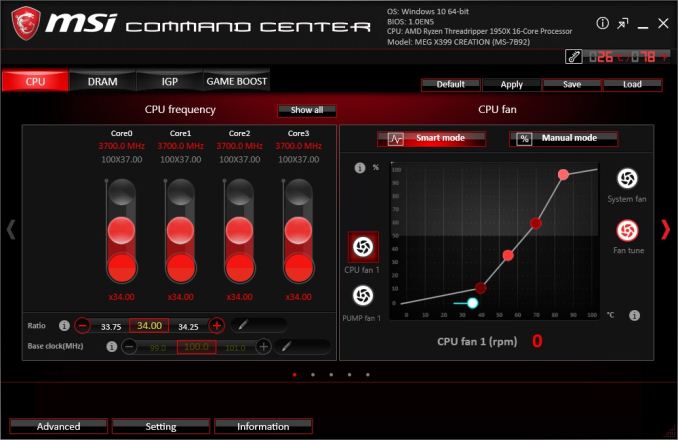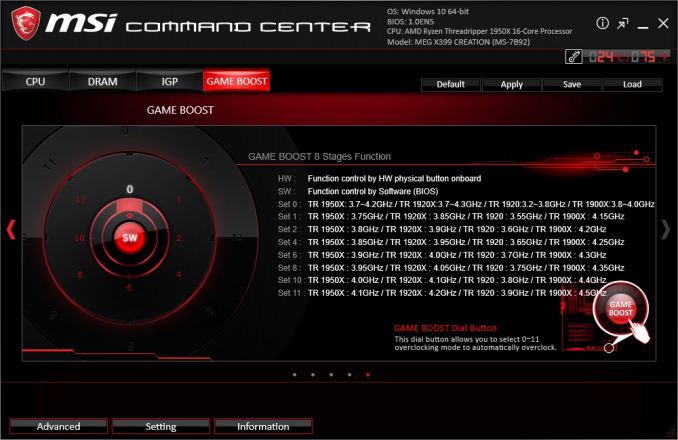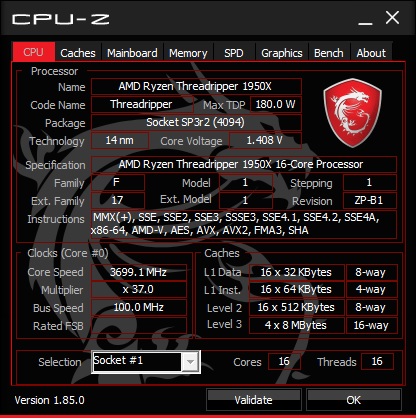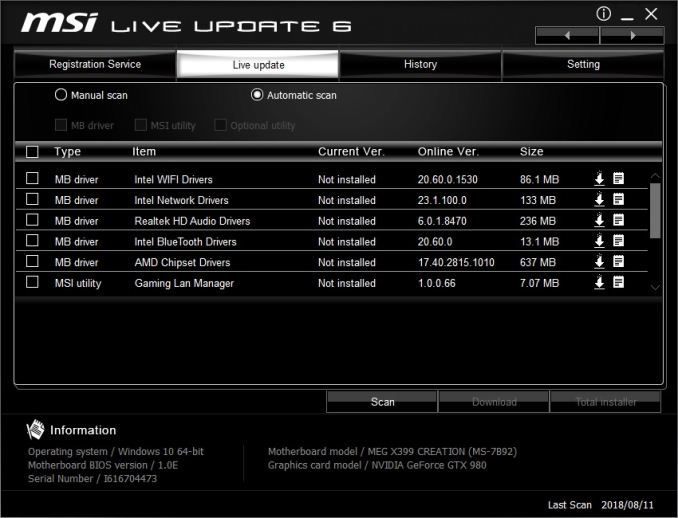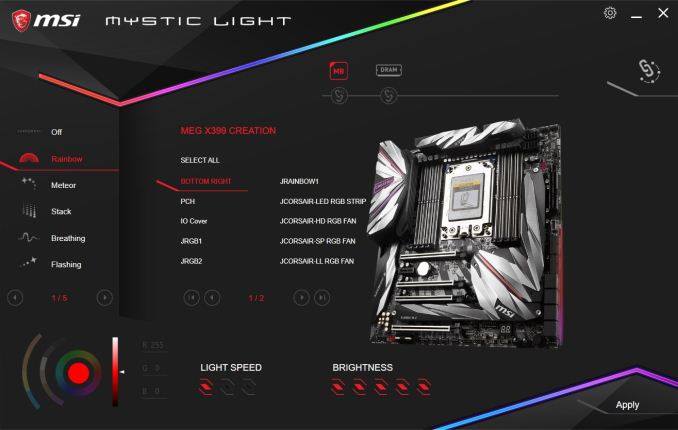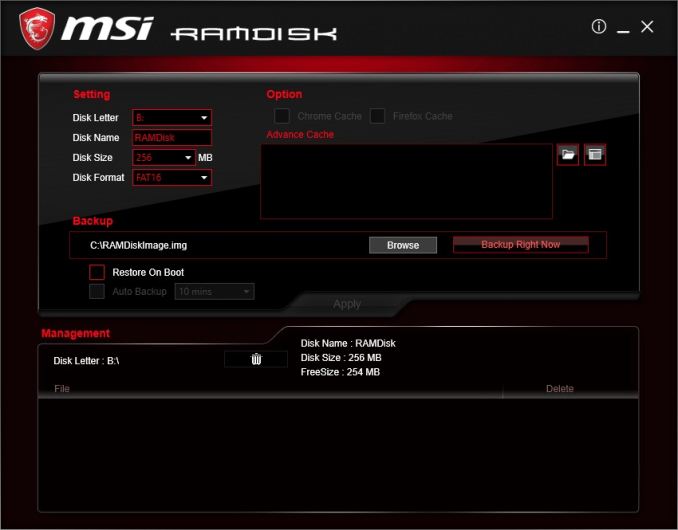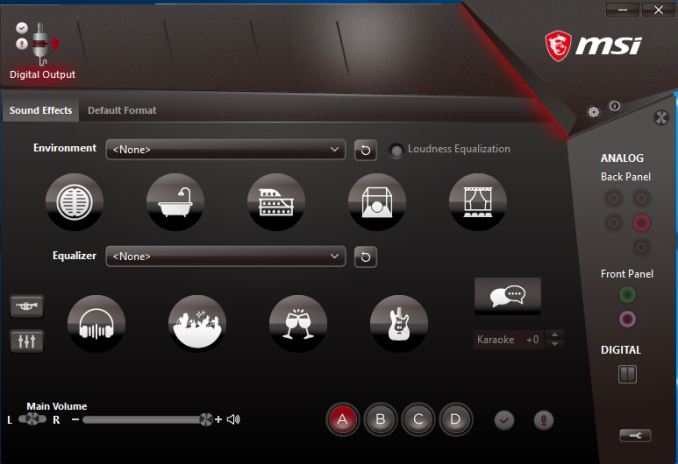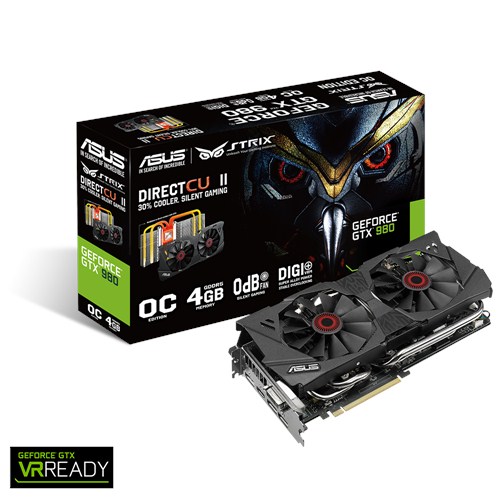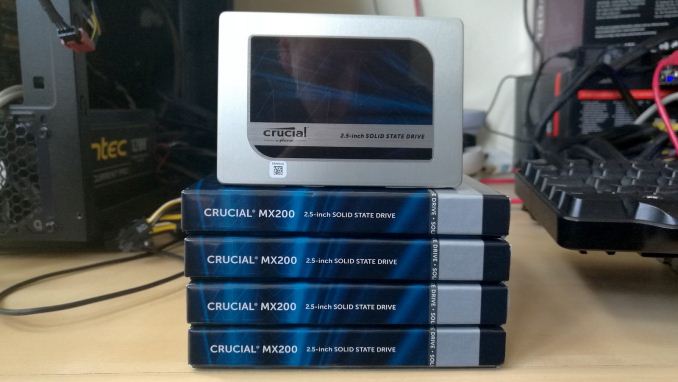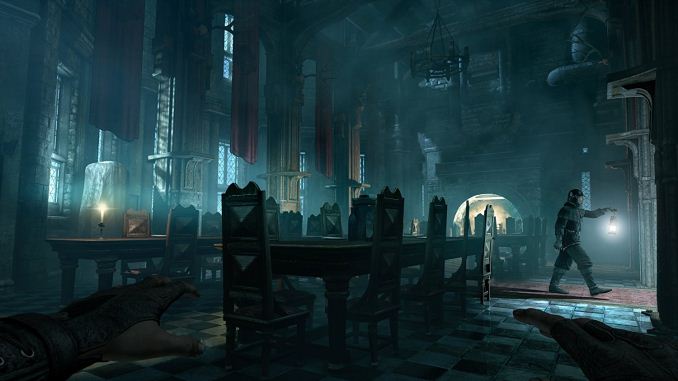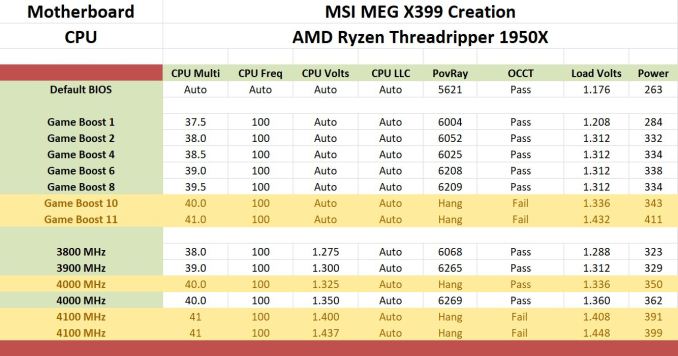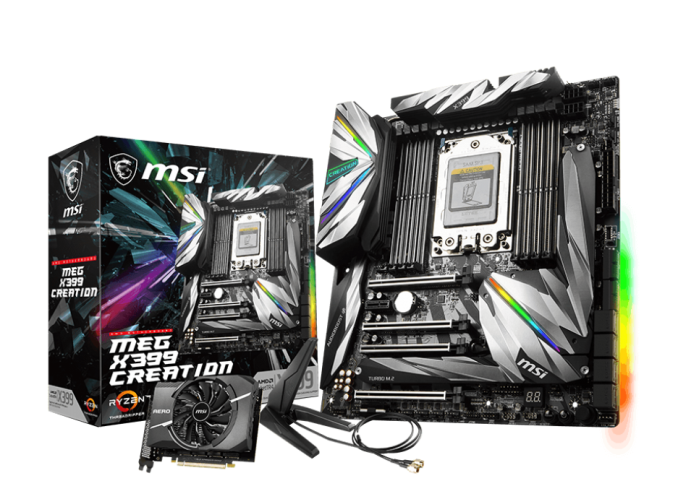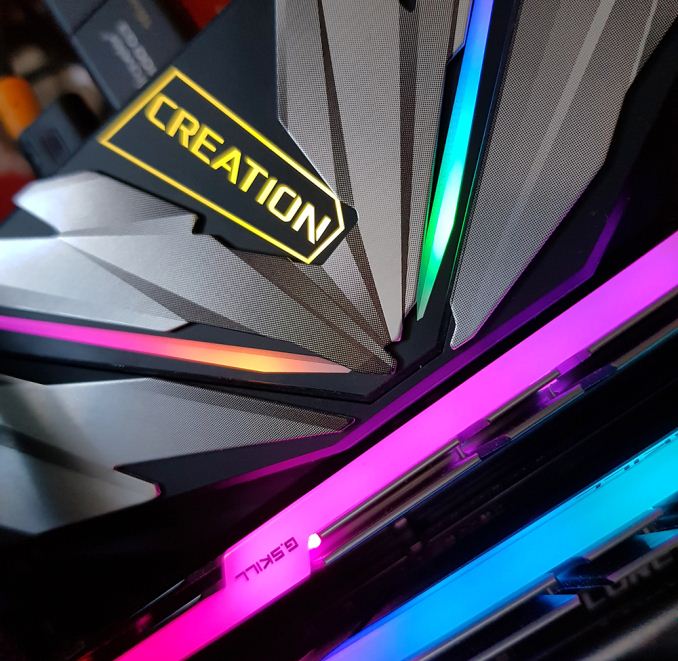
Original Link: https://www.anandtech.com/show/13189/the-msi-meg-x399-creation-motherboard-review
The MSI MEG X399 Creation Motherboard Review: The New 16-Phase Shark In Town
by Gavin Bonshor on August 13, 2018 8:59 AM EST- Posted in
- Gaming
- AMD
- MSI
- Motherboards
- Overclocking
- ThreadRipper
- X399
- TR4
- Threadripper 2
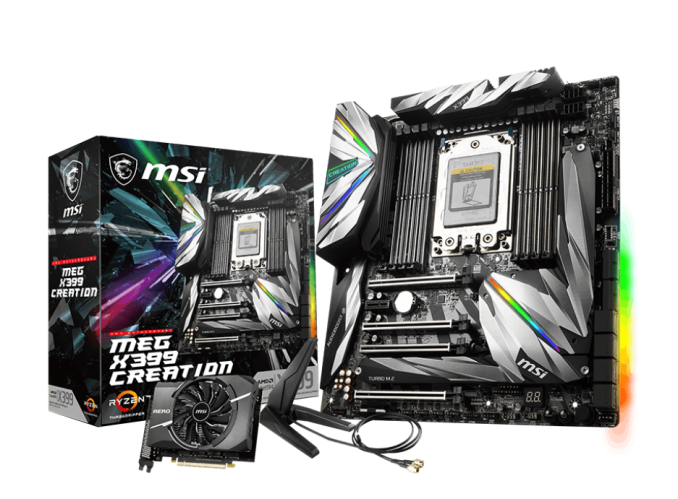
With the highly anticipated launch of AMD's second generation Threadripper processors, it gives motherboard vendors the incentive and justification to release more boards. As there aren’t tons of Threadripper 2-validated boards to currently choose from, MSI has released the new MEG X399 Creation with content creators and designers the targeted focus. This review aims to explore what the X399 Creation has to offer and see what all the fuss is about.
Other AnandTech Ryzen Threadripper Coverage
- The ASUS X399 ROG Zenith Extreme Motherboard Review: Top Tier Threadripper
- GIGABYTE's X399 Aorus Extreme: The Threadripper 2 Halo Motherboard
- The AMD Threadripper 2 Teaser: Pre-Orders Start Today, Up to 32 Cores
- The ASRock X399 Professional Gaming Motherboard Review: 10G For All
- The GIGABYTE X399 DESIGNARE EX Motherboard Review
The MSI MEG X399 Creation Motherboard Overview
The MSI MEG X399 Creation is an E-ATX form factor motherboard on AMD’s X399 chipset and has a variety of features specifically aimed towards professional users and content creators such as dual Intel Gigabit LAN, integrated 2T2R Wave 2 capable Wi-Fi, and it also has support for Bluetooth 5. The MEG X399 Creation has a very unique design which takes shades of MSI’s own X399 SLI Plus and combines it with the silvery overall look seen on their Titanium range. The PCB itself is black with silver colored patterning which mirrors that of the black and silver design of the heatsinks. Integrated into the board at various points including the rear IO cover, the chipset heatsink and underneath the SATA ports is RGB LEDs which can be controlled, customized and synced together with MSI’s Mystic Light software.
The new AMD Ryzen Threadripper processors do bring an added number of cores and threads in comparison to the first generation of Threadripper, with the workstation-focused Threadripper 2990WX in particular doubling AMD's core and thread count versus the original Threadripper 1950X processor. While there are core differences as outlined within our Threadripper 2 review, there admittedly isn’t anything definitively new with the MEG X399 Creation that last year's launch X399 boards couldn’t have included. Instead, MSI has opted to go all-out on features and has gone to extreme measures to fill out as much of the available E-ATX PCB space as they could with the aim to produce one of the most feature packed AMD motherboards physically possible.
Pricing-wise the MEG X399 Creation comfortably sits as MSI’s most expensive X399 motherboard, with a price tag of $500. This is $100 more than MSI’s X399 Gaming Pro Carbon AC and around the same mark as the ASUS X399 ROG Zenith Extreme. The pricing is a consequence of MSI piling feature upon feature onto the E-ATX PCB, with things like dual Intel LAN, 2T2R Wave 2 capable Wi-Fi, and what MSI is advertising as a sixteen-phase power delivery system.
Another indication of where the development budget has been spent is on the rear panel, as the MSI MEG X399 has implemented a total of eight USB 3.1 Gen1 Type-A ports, with MSI also including a pair of USB 3.1 Gen2 ports with both a single Type-A and Type-C connector. The latter ports' USB 3.1 Gen2 capability comes thanks to a single ASMedia 3142 USB controller. The two included LAN ports are powered by a pair of Intel I211-AT Gigabit networking controllers, with the 2T2R Wi-Fi and Bluetooth 5 capabilities coming thanks to a single Intel 9620 Wi-Fi card. This enables the onboard Wi-Fi to support connections up to a maximum of 1.73 Gbps of speed. In regards to the onboard audio, the MSI MEG X399 Creation features audio PCB separation, with the single Realtek ALC1220 audio codec being complemented by a total of nine gold dedicated audio capacitors with five larger ones coming from Japanese based Nippon Chemi-con.
MSI’s aim clearly hasn’t been to just support content creators, but also enthusiasts, thanks to the plethora of cooling options scattered across the board. The MEG X399 Creation has support for up to ten 4-pin fans with a divide between water cooling support and air cooling. This is apparent as there is a single for AIO CPU coolers/water pumps, a single header for a CPU fan, a total of five system fan headers and room to expand to an additional three fan headers; all the aforementioned headers all feature a 4-pin interface and support PWM capable fans.
Touching on the storage capabilities of the MEG X399 Creation, MSI has included a total of eight SATA ports which are governed by the X399 chipset, with support for RAID 0, 1, and 10 arrays. A trio of M.2 slots is also provided with bandwidth coming specifically from the processor, with all three slots featuring both support for PCIe 3.0 x4 and SATA drives. It should be noted that M2 slot_1 and M2 slot_3 only support drives up to the M.2 2280 form factor, while M.2 slot_2 allows for slightly bigger drives up to M.2 22110. All these M.2 slots benefit from MSI's M.2 Shield Frozr heatsinks to aid in cooling when used with decent passive airflow within a competent chassis.
Memory capability and support comes through eight RAM slots which allow for up to a maximum of 128 GB of DDR4 memory to be installed. Threadripper and Threadripper 2 both support quad channel memory, so users can make use of the extra bandwidth available and specifically with the X399 Creation, there is support for memory up to speeds of DDR4-3600; this is the norm for a top tier TR4 socketed motherboard.
Included within the packaging and bundle is the M.2 Xpander-Aero M.2 PCIe card. This has support for up to four M.2 NVMe drives, with each slot capable of running PCIe 3.0 x4. The crux of the Xpander-Aero from a design point of view is the inclusion of a GPU styled cooling fan. The Aero cooler is more than capable of keeping every installed drive cool with a 6-pin 12V graphics card power connector if more power is required.
While the composition of the test bed between our X399 motherboards varies slightly from previous reviews, the compute performance of the MSI MEG X399 Creation is on par with other X399 motherboards we have previously tested such as the ASUS X399 ROG Zenith Extreme and the GIGABYTE X399 DESIGNARE EX. Power consumption was marginally higher than the rest of the field under load, but this could quite easily be due to the switch in graphics cards from an AMD RX 570 to a beefier NVIDIA GTX 980. The power consumption at full load however did prove slightly more economical than the ASUS X399 ROG Zenith Extreme board by around 10 W at peak.
One very strange anomaly was discovered in POST time in both a default and stripped state. For some unknown reason the time it took to get into Windows in comparison to other boards doubled, and in some cases was even tripled. Meanwhile none of the X399 boards we've tested are optimized for DPC latency, and according the X399 Creation has delivered some of the highest latency numbers we've seen among the five boards tested, but other than that everything seemed to look as it should in regards to performance given versus performance expected.
The overclocking performance of the MSI MEG X399 proved fruitful for the most part with our testbed Ryzen Threadripper 1950X, as our chip managed a stable overclock of 4.0 GHz with the CPU core voltage set to 1.35 V. Usually when it comes to the vendors pre-defined overclockers, they tend to come with modest overclocks with copious amounts of unwanted voltage, which not only increases power draw significantly (especially on a 16-core 32-thread CPU) but it also contributes to extra strain on VRMs, as well as extra heat. We had the opposite problem when it came to running at 4.0 GHz at the MSI Game Boost 10 profile with it undervolting what our 1950X required to be stable. And while this may not seem like a big thing, it's quite welcomed as all the pre-defined settings up to and including the Game Boost 8 setting we're 100% stable with reasonable amounts of voltage.
The MSI MEG X399 Creation is clearly designed to please more than just content creators and professional users, especially given the tools and features included. The sixteen-phase power delivery and dual 8-pin 12 V CPU power inputs are something extreme overclockers and hardcore enthusiasts will be interested in, and the eight SATA ports in addition to the three M.2 PCIe 3.0 x4 slots built-in are something workstation users and video renderers will be keen to take advantage of. Dual LAN is certainly an advantage, although dual Gigabit isn’t as advantageous and desirable as 10GigE (especially for $500), it could be quite a hard fact to ignore throughout the review. Despite this, there’s plenty to feast into for virtually all users and with lots to consider, users looking to take advantage of AMD’s monstrous core-laden Threadripper processors might be looking for this board to deliver more than it’s capable of, especially for the hefty $500 cost associated.
Visual Inspection
The MSI MEG X399 Creation is an E-ATX motherboard with a ton of features and a specification list which would make other boards on a different chipset wish they were as well equipped. The X399 Creation has a lot going on visually with a black PCB embossed with a light grey patterning which matches with the rear panel cover, as well as the power delivery and combined M.2/chipset heatsink. The board does have a lot of RGB LED lighting onboard which has been integrated into various areas such as the rear panel cover, chipset heatsink and just underneath the SATA ports to give users the ability to create an ominous rainbow glow; users can sync the RGB up using the MSI Mystic Light software. MSI has also implemented a single Addressable RGB LED strip as well as two 5050 RGB LEDs to further expand the rainbow disco capabilities of the board.
Memory support comes via eight RAM slots which support up to DDR4-3600. A maximum capacity of up to 128 GB can be installed across all the available slots, with both dual and quad channel memory being supported thanks to AMD implementing this into their X399 HEDT platform. The board has a total of four full length PCIe 3.0 x16 slots with each slot getting MSI’s Steel Armor slot protection. All alone is a single PCIe 2.0 x1, which is nestled in between the top and second full-length slots. The MEG X399 Creation supports up to three-way AMD CrossFire and NVIDIA SLI multi-graphics card configurations which allows the final full-length slot to be used with the Xpander-Aero M.2 PCIe card to extend the board's storage capacity by up to four additional M.2 drives.
Cooling has also been another key focus with a combined total of ten 4-pin fan connectors. These are divided and located around the edge of the PCB into a single header for the CPU fan, a dedicated header for a water pump/AIO CPU cooler pump, five system headers and three extend fan connectors. This represents an upgrade in options over MSI’s own X399 Gaming Pro Carbon AC motherboard which has a total of six 4-pin headers available.
In addition to the extra four M.2 slots provided by the Xpander-Aero M.2 PCIe card brings to the table, MSI has implemented three M.2 PCIe 3.0 x4 slots, with two of the slots supporting up to M.2 2280 drives and one allowing for up to M.2 22110 drives to be installed. All three M.2 slots can support SATA based drives, and all benefit from MSI’s M.2 Shield Frozr heatsink, with the M.2 array being arranged in an L shape around the X399 PCH chipset. Also featured are eight right-angled SATA ports with support for RAID 0, 1 and, 10 arrays. Featured just below the M.2 slots is an overclockers toolkit consisting of a power button, a reset button and MSI's Click OC dial which has seven different CPU overclocking states which users can access without manually changing settings. The frequencies generated completely depends on the installed processor. Each Game Boost setting was tested for in the overclocking section of this review. There is also a debug LED which is handy for overclockers and diagnosing POST issues, or lack of POST in some cases.
On paper, the MSI MEG X399 creation has a nineteen-phase power delivery, which it indeed does, but upon closer inspection, the CPU phase is actually split into two banks of eight due to MSI electing to make use of eight Infineon IR3599 doublers. The CPU area is formidable with MSI opting for sixteen Infineon TDA21472 dual power stages for the CPU VCore and CPU input voltage. Each of the sixteen TDA21472 power stages has its own dedicated choke with the CPU section taking direction from an International Rectifier IR35201 eight phase PWM controller operating at 8+0.
An International Rectifier IR35204 four phase controller is dedicated to memory/SOC, with this controller operating at 3+0 and controlling three Infineon TDA21472 power stages. In addition to this is four Texas Instruments NexFET 87350 MOSFETs for the memory, as well as a Primarion PV4210 digital PWM.
| X399 Motherboard CPU Power Delivery | |||||
| Motherboard | Controller | H-Side | L-Side | Chokes | Doubler |
| MSI MEG X399 Creation | IR35201 8+0 | 16 | 16 | 16 | 8 x IR3599 |
| ASUS X399 ROG Zenith Extreme |
ASP1405 8+0 |
8 | 8 | 8 | - |
The X399 Creation also features dual 8-pin 12 V ATX power inputs to deliver power to the processor with up to 720 W of power being supported. The power delivery heatsink also feels good quality and I have no fears that it wouldn’t be up to the task of cooling any current Ryzen Threadripper processor in ambient cooled situations.
As with most consumer-level motherboards with an element of gaming focus, MSI has included a single Realtek ALC1220 audio codec, which offers support for 7.1 surround sound on the rear panel. In addition to the five 3.5mm gold plated audio jacks on the rear, ALC1220 also provides a single S/PDIF optical output. The Realtek ALC1220 codec itself doesn’t feature any EMI shielding, but MSI has included audio PCB separation as well as seven gold audio capacitors, four of them hailing from Japanese manufacturer Nippon Chemi-Con.
The rear panel has a lot going on, with MSI looking to satisfy content creators and users that require plenty of USB real estate from their motherboard. USB-wise the rear panel has a total of eight USB 3.1 Gen1 ports, with four ASMedia ASM1464 USB 3.1 Gen1 USB controllers on the rear of the PCB. Adopters of 10 Gbps-capable USB devices will be pleased to know a single ASMedia 3142 USB 3.1 Gen2 controller is present which translates to both a Type-A and Type-C USB 3.1 Gen2 port being featured. There is two RJ45 LAN ports which are each powered by separate Intel I211-AT Gigabit controllers, while the five 3.5mm gold plated audio jacks and S/PDIF optical output are governed by the Realtek ALC1220 audio codec. The two antenna slots are for the Intel 9260 802.11ac Wi-Fi which allows the installation of the 2T2R antennas, which provides Wave 2 Wi-Fi functionality with speeds up to 1.73 Gbps, as well as offering Bluetooth 5 support to boot. Finishing off the rear panel is a clear CMOS and a BIOS Flashback+ button.
What's in The Box
The bundle with the MSI MEG X399 Creation has everything needed to get a system up and running including the 2T2R Wave 2 capable Wi-Fi antenna. The additional thermal probes allow for temperature monitoring at user-defined locations within a system and the graphics cooler inspired Xpander-Aero M.2 PCIe card is a nice and welcomed addition; one would perhaps expect a little more from a $500 flagship motherboard, perhaps a 3-way SLI HB bridge in addition to the 2-way one provided.
- User manual and quick start guide
- 3 x Thermal probes
- 4 x SATA cables (2 right-angled, 2 straight-angled)
- Rear IO shield
- MSI Gaming shield sticker
- MSI thank you card
- 2 x RGB extension cables
- 2-way NVIDIA SLI HB bridge
- 3 x M.2 mounting screws
- 2T2R Wave 2 Wi-Fi antenna
- Driver installation disk
- MSI Xpander-Aero 4-way M.2 PCIe card
BIOS
MSI so far has retained the same BIOS UI throughout all of their Zen architecture motherboards, including the more entry-level B350 and B450 chipsets, as well as the more feature-rich X370 and X470 chipsets. It’s good to know that MSI follow a consistent pattern in regards to their UEFI BIOS, as their X399 chipset offerings carry the same UEFI layout which they call Click BIOS 5. The general layout consists of a black background with reddened highlighting, with white text to help to make the contrast work visually. Like all of MSI’s Click BIOS 5 equipped motherboards, pressing F7 on the initial splash screen switches to the more advanced mode, where more experienced users can find a variety of settings for overclocking, enabling and disabling certain features, and tweaking the AMD-based power properties.
Entering the BIOS during post can be accomplished by pressing the F2 or Del key during POST, which in turn brings up the initial splash screen, which MSI called EZ mode. This screen provides a basic overlay and provides plenty of informative details throughout the different panels, including information on the installed processor, memory, and storage. It also allows users to set custom fan profiles with control for each of the ten 4-pin headers dotted around the board. The top part of the panel remains the same throughout the BIOS and allows users to enable and set different stages of Game Boost; this is a bank of pre-defined overclocking profiles with each different processor having different features, dependent on what MSI deem appropriate settings-wise. The top panel also has a clickable A-XMP button which can enable or disable the RAMs X.M.P memory profile without having to deep dive into the advanced section of the BIOS.
Pressing F7 grants access to the advanced mode, which opens up an overabundance of customizable options. This includes all those overclocking settings through the OC section, easy access to the M-Flash firmware updater, quick access to any custom overclocking profiles, as well as a hardware monitor and the board explorer. The center of this version of the Click BIOS 5 is tailored to the Creation with a big bang-styled futuristic explosion in the center; very similar in design to the rear panel cover on the board itself.
With a nineteen-phase power delivery, users might be tempted to stretch the silicon in their system, and I personally would probably visit the OC panel first. As expected, the OC settings section allows users to overclock the CPU and memory. While MSI do include the Game Boost button (on the PCB and within the BIOS), usually vendors tend to pump too much voltage throughout the CPU, which might be fine from a stability point of view, but in other aspects it can be quite troublesome, especially if an adequate cooling solution isn’t used.
Options here include CPU core frequency tweaking through a CPU multiplier ratio, in increments of 100 MHz, as well as through base clock overclocking. For the latter the X399 Creation does house an external clock generator, something sub-zero overclockers will be happy about. All the usual suspects in terms of voltages are present such as core voltage, memory voltage and more obscure voltages such as VDDP. Users can also adjust memory latency timings with these settings being found in the advanced DRAM configuration sub menu.
The Performance Regular setting allows users to enable profile-based tweaks for certain benchmarks such as Cinebench R15, which in the real world is pointless but from an overclockers perspective, it could be handy and provide a slight advantage over someone not using this feature.
The hardware monitor section is one we’ve seen numerous times before and is one of the better implemented ones from motherboard vendors. The ability to set individual fan curve profiles based on temperature is done well, especially given there are ten 4-pin headers to control. Of course, the options are there to enable every header to operate at maximum speed and basic temperature monitoring with voltage monitoring is also available for viewing towards the bottom of the screen.
Just as with the hardware monitor, another welcomed feature is present on X399 via the board explorer. Given that the MEG X399 Creation has a lot of USB connectivity, eight RAM slots, and four full-length PCIe 3.0 x16 lanes, the board explorer allows users to see a bird’s eye view of their motherboard, with each installed component being highlighted up in red. Click on the rear panel cover on the board explorer brings up the rear IO and as is with the main area, highlights each populated port up in red.
The MSI Click BIOS 5 UEFI BIOS works well and does so in a visually pleasing manner. The GUI is responsive and intuitive and the help section is one of the best from all of the available motherboard vendors. There are plenty of options to tweak and overclocking is made easy through the OC section. One very neglected area of the BIOS is the lack of RGB control options, even though I’m generally highly critical of vendors who use primitive means of RGB customization within the BIOS, at least they attempt to include some controls whereas MSI has included none within. Users looking to make use and set their own RGB LED profiles will need to do so by installing the MSI Mystic Light software via the provided CD, or download the latest version directly from the support section on the MSI MEG X399 Product page.
Software
Just like in our previous reviews of MSI motherboards, it's no secret that there's oodles of software to choose from. Software such as the MSI Mystic Light utility offer customization of the onboard and extended RGB capabilities of the board, as well as others like the MSI Command Center which allows users to overclock their system without having to enter the BIOS. Just like on MSI's Gaming branded range of motherboards, most of the included software is specifically aimed at gamers with MSI's RAMDISK being one of the only utilities somewhat aimed towards content creators and enthusiasts.
The MSI Command Center utility provides a variety of informative monitoring abilities as well as allowing users to overclock their system within Windows. The CPU frequency option enables users to either click and drag the interactive slider up to the desired core clock speed, or it can be done incrementally in steps of 25 MHz via the + and - buttons just below. Just like the CPU, memory can also be overclocked and while there are no options to increase or alter the memory straps, overclocking can be done by adjusting the base clock. The Command Center app does inhibit the ability to directly change memory voltages, and instead users can select through the different Game Boost profiles and enable them this way. The MSI Command Center app also includes a hardware monitor similar to what's inside the BIOS and has a slightly less intimidating fan profile selection tool.
The Game Boost section is actually quite detailed and gives users information on what each setting applies, so setting stage 4 would apply a Ryzen Threadripper 1950X with a core ratio of 3.85 GHz. The software also highlighted what the settings would be on other relevant processors such as the Threadripper 1920X and the lower spec Threadripper 1920 and 1900X.
A custom MSI Gaming themed CPU-Z skin is available to download, or via the installation CD (though it's always recommended once online to update to the latest version). CPU-Z is a monitoring utility created by CPUID and allows users the ability to monitor CPU core voltage, CPU frequency as well as the set multiplier, base clock (bus) speed, and other CPU and memory relevant settings such as CAS latency timings and memory frequency.
MSI's Live Update 6 software can be quite useful for updating motherboard drivers and software to the latest versions. Users can download with the intention to install manually or use the total installer button which downloads the software and installs it automatically saving time. There are options to scan for software automatically or manually if there's a certain app or utility that's required, although a full list of supported utilities can be installed directly from the installation CD, or via the product page from the MSI website.
As it stands, the MSI Click BIOS 5 UEFI firmware has no options for adjusting and customizing the built-in RGB LEDs. With that being said, the MSI Mystic Light utility gives loads of options and lighting effects to select from. The lighting effects on display represent one of the most comprehensive selections of RGB options available from software I have seen thus far with rainbow, meteor and lightning being my particular favorites. Users can adjust the lighting effect speed, the LED brightness and sync up compatible hardware to operate with a uniformed and clean look. If a user wishes to do so, they can individually set each section of LEDs and header to the desired color.
The MSI RAMdisk software affords users the ability with high capacity DDR4 to create a virtual RAM drive. The storage capabilities of a RAMdisk far surpass the transfer speed and seek time of conventional hard drives. Unlike the storage of a hard drive or SSD, RAMdisk is only temporary and can be reduced, increased or removed completely at the click of a button. Any data stored within the RAM will be lost forever once deleted, just as if a regular storage drive were to be formatted.
With the MSI MEG X399 Creation utilizing a Realtek ALC1220 audio codec – and with the board having a premium theme given the $500 pricing – MSI has included a custom MSI skinned version of the Realtek Audio Manager utility, which looks far nicer in design and feels more responsive. Included are options to add environment-based effects such as stone room, auditorium, and padded cell (ed: all but necessary for hardware reviewers), as well as different equalizer profiles for various genres of music such as pop, rock and even more vocal focused tracks. Clicking the equalizer button brings up ten different sliders which allow for custom settings to be used, with decibel control available for lower, mid and higher frequencies ranging from 31 Hz to 16 K.
As previously mentioned, the majority of the software included with the X399 Creation is primarily gaming focused, and with this board being aimed towards content creators and consumer level workstation users, the board does represent a high-end option that could be a powerful foundation for a powerful gaming system, or an indomitable video rendering machine.
Board Features
When it comes to hardware features MSI has given the MEG X399 Creation all it can, with elements suited for workstation users such as dual Intel LAN, features gamers can sick their teeth into such as a Realtek ALC1220 audio codec, and a beefy power delivery for the most ardent of overclockers. The X399 Creation has a total of three M.2 PCIe 3.0 x4 slots, with the middle of the three slots getting extra attention thanks to an integrated M.2 heatsink (which shares cooling responsibility with the chipset heatsink). If you can imagine an amalgamation between a gaming and workstation motherboard, the MEG X399 Creation would be it.
| MSI MEG X399 Creation E-ATX Motherboard | |
| Warranty Period | 3 Years |
| Product Page | Link |
| Price | $500 |
| Size | E-ATX |
| CPU Interface | TR4 / SP3r2 |
| Chipset | AMD X399 |
| Memory Slots (DDR4) | Eight DDR4 Supporting 128GB Quad Channel Up to DDR4-3600 |
| Video Outputs | N/A |
| Network Connectivity | 2 x Intel I-211AT Gigabit (1 GigE) Intel 9260NGW 802.11ac Wi-Fi (Wave 2) |
| Onboard Audio | Realtek ALC1220 |
| PCIe Slots for Graphics (from CPU) | 4 x PCIe 3.0 (x16) |
| PCIe Slots for Other (from PCH) | 2 x PCIe (x1) |
| Onboard SATA | Eight, RAID 0/1/10 |
| Onboard M.2 | 1 x PCIe 3.0 x4/SATA (middle slot) - 22110 2 x PCIe 3.0 x4/SATA (top / bottom slot) - 2280 |
| USB 3.1 (10 Gbps) | 1 x Type-A 1 x Type-C |
| USB 3.0 (5 Gbps) | 8 x Rear Panel (Type-A) 4 via Header |
| USB 2.0 | 4 via Header |
| Power Connectors | 1 x 24-pin ATX 2 x 8-pin CPU 1 x 4-pin Molex PCIe |
| Fan Headers | 1 x CPU (4-pin) 6 x System (4-pin) 3 x extend fan (4-pin) |
| IO Panel | 1 x USB 3.1 Type-A (USB 3.1 Gen 2) 1 x USB 3.1 Type-C (USB 3.1 Gen 2) 8 x USB 3.1 Type-A (USB 3.1 Gen 1) 2 x Network RJ-45 (Intel) 5 x 3.5 mm Audio Jacks (Realtek) 1 x S/PDIF (Realtek) 1 x BIOS Flashback+ Button 1 x Clear CMOS Button 2 x MMCX antenna connectors (2T2R) |
The inclusion of the Xpander-Aero M.2 PCIe card allows for an additional four NVMe M.2 drives to be installed. MSI also omitted to include a 10G LAN port and opted to use dual 1 GigE LAN instead. MSI has also included 802.11ac Wave2 Wi-Fi capability for users looking to utilize high-speed wireless networks. There has also been a massive focus on providing one of the best set of cooling options they have offered on a motherboard of late with a total of ten 4-pin fan headers dotted across the PCB. The X399 Creation also offers users ten USB ports with the capacity to extend this by a further eight through the use of internal headers.
Test Bed
As per our testing policy, we take a high-end CPU suitable for the motherboard that was released during the socket’s initial launch, and equip the system with a suitable amount of memory running at the processor maximum supported frequency. This is also typically run at JEDEC subtimings where possible.
It is noted that some users are not keen on this policy, stating that sometimes the maximum supported frequency is quite low, or faster memory is available at a similar price, or that the JEDEC speeds can be prohibitive for performance. While these comments make sense, ultimately very few users apply memory profiles (either XMP or other) as they require interaction with the BIOS, and most users will fall back on JEDEC supported speeds - this includes home users as well as industry who might want to shave off a cent or two from the cost or stay within the margins set by the manufacturer. Where possible, we will extend out testing to include faster memory modules either at the same time as the review or a later date.
| Test Setup | |||
| Processor | AMD Ryzen Threadripper 1950X, 16 Cores, 32 Threads, 3.4 GHz (4.0 GHz Turbo) |
||
| Motherboard | MSI MEG X399 Creation (BIOS 7B92v10) | ||
| Cooling | Thermaltake Floe Riing RGB 360 | ||
| Power Supply | Thermaltake Toughpower Grand 1200W Gold PSU | ||
| Memory | 4x8GB GSkill TridentZ RGB DDR4-3200 | ||
| Memory Settings | DDR4-2666, 1.2 V, 16-18-18-35 1T | ||
| Video Card | ASUS GTX 980 STRIX (1178/1279 Boost) | ||
| Hard Drive | Crucial MX300 1TB | ||
| Case | Open Test Bed | ||
| Operating System | Windows 10 Pro 64-bit | ||
Readers of our motherboard review section will have noted the trend in modern motherboards to implement a form of MultiCore Enhancement / Acceleration / Turbo (read our report here) on their motherboards. This does several things, including better benchmark results at stock settings (not entirely needed if overclocking is an end-user goal) at the expense of heat and temperature. It also gives, in essence, an automatic overclock which may be against what the user wants. Our testing methodology is ‘out-of-the-box’, with the latest public BIOS installed and XMP enabled, and thus subject to the whims of this feature. It is ultimately up to the motherboard manufacturer to take this risk – and manufacturers taking risks in the setup is something they do on every product (think C-state settings, USB priority, DPC Latency / monitoring priority, overriding memory sub-timings at JEDEC). Processor speed change is part of that risk, and ultimately if no overclocking is planned, some motherboards will affect how fast that shiny new processor goes and can be an important factor in the system build.
Many thanks to...
Thank you to ASUS for providing us with GTX 980 Strix GPUs. At the time of release, the STRIX brand from ASUS was aimed at silent running, or to use the marketing term: '0dB Silent Gaming'. This enables the card to disable the fans when the GPU is dealing with low loads well within temperature specifications. These cards equip the GTX 980 silicon with ASUS' Direct CU II cooler and 10-phase digital VRMs, aimed at high-efficiency conversion. Along with the card, ASUS bundles GPU Tweak software for overclocking and streaming assistance.
The GTX 980 uses NVIDIA's GM204 silicon die, built upon their Maxwell architecture. This die is 5.2 billion transistors for a die size of 298 mm2, built on TMSC's 28nm process. A GTX 980 uses the full GM204 core, with 2048 CUDA Cores and 64 ROPs with a 256-bit memory bus to GDDR5. The official power rating for the GTX 980 is 165W.
The ASUS GTX 980 Strix 4GB (or the full name of STRIX-GTX980-DC2OC-4GD5) runs a reasonable overclock over a reference GTX 980 card, with frequencies in the range of 1178-1279 MHz. The memory runs at stock, in this case 7010 MHz. Video outputs include three DisplayPort connectors, one HDMI 2.0 connector and a DVI-I.
Further Reading: AnandTech's NVIDIA GTX 980 Review
Thank you to Crucial for providing us with MX200/MX300 SSDs. Crucial stepped up to the plate as our benchmark list grows larger with newer benchmarks and titles, and the 1TB units are strong performers. The MX200s are based on Marvell's 88SS9189 controller and using Micron's 16nm 128Gbit MLC flash, these are 7mm high, 2.5-inch drives rated for 100K random read IOPs and 555/500 MB/s sequential read and write speeds. The 1TB models we are using here support TCG Opal 2.0 and IEEE-1667 (eDrive) encryption and have a 320TB rated endurance with a three-year warranty.
Further Reading: AnandTech's Crucial MX200 (250 GB, 500 GB & 1TB) Review
Thank you to Corsair for providing us with Vengeance LPX DDR4 Memory
Corsair kindly sent a set of their Vengeance LPX low profile, high-performance memory. The heatsink is made of pure aluminum to help remove heat from the sticks and has an eight-layer PCB. The heatsink is a low profile design to help fit in spaces where there may not be room for a tall heat spreader; think a SFF case or using a large heatsink.
System Performance
Not all motherboards are created equal. On the face of it, they should all perform the same and differ only in the functionality they provide - however, this is not the case. The obvious pointers are power consumption, but also the ability for the manufacturer to optimize USB speed, audio quality (based on audio codec), POST time and latency. This can come down to the manufacturing process and prowess, so these are tested.
Power Consumption
Power consumption was tested on the system while in a single ASUS GTX 980 GPU configuration with a wall meter connected to the Thermaltake 1200W power supply. This power supply has ~75% efficiency > 50W, and 90%+ efficiency at 250W, suitable for both idle and multi-GPU loading. This method of power reading allows us to compare the power management of the UEFI and the board to supply components with power under load, and includes typical PSU losses due to efficiency. These are the real world values that consumers may expect from a typical system (minus the monitor) using this motherboard.
While this method for power measurement may not be ideal, and you feel these numbers are not representative due to the high wattage power supply being used (we use the same PSU to remain consistent over a series of reviews, and the fact that some boards on our test bed get tested with three or four high powered GPUs), the important point to take away is the relationship between the numbers. These boards are all under the same conditions, and thus the differences between them should be easy to spot.



Aside from the other four boards being tested, the only major differences in specification are the graphics card and power supply used. In OCCT, the only variations are in the idle power draw of the components, but it's still a good indication of where power consumption should be. The MSI X399 Creation in a long idle and idle state pull slightly more watts at the wall than the other boards on test, but at full loud under OCCT, the power draw falls below that of the ASUS X399 ROG Zenith Extreme; a board on the same level specifications, feature and price wise.
Non-UEFI POST Time
Different motherboards have different POST sequences before an operating system is initialized. A lot of this is dependent on the board itself, and POST boot time is determined by the controllers on board (and the sequence of how those extras are organized). As part of our testing, we look at the POST Boot Time using a stopwatch. This is the time from pressing the ON button on the computer to when Windows starts loading. (We discount Windows loading as it is highly variable given Windows specific features.)
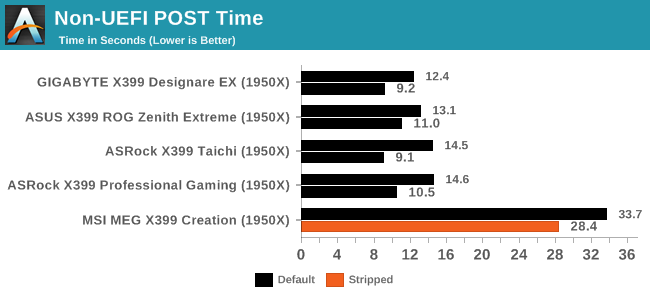
While the boot times of the other boards on test seem very quick indeed, the MSI MEG X399 Creation displayed some very long and dreary POST times. In a stripped state with controllers such as LAN, onboard audio and other disableable controllers turned off, POST times did improve but still come in more than double than the next slowest board. This could quite possibly be an anomaly, but as more X399 boards come in, I will re-test to see if it's a consistent issue with the test set-up, although nothing else seems amiss.
DPC Latency
Deferred Procedure Call latency is a way in which Windows handles interrupt servicing. In order to wait for a processor to acknowledge the request, the system will queue all interrupt requests by priority. Critical interrupts will be handled as soon as possible, whereas lesser priority requests such as audio will be further down the line. If the audio device requires data, it will have to wait until the request is processed before the buffer is filled.
If the device drivers of higher priority components in a system are poorly implemented, this can cause delays in request scheduling and process time. This can lead to an empty audio buffer and characteristic audible pauses, pops and clicks. The DPC latency checker measures how much time is taken processing DPCs from driver invocation. The lower the value will result in better audio transfer at smaller buffer sizes. Results are measured in microseconds.

None of the boards tested has been optimized for DPC latency, and as it stands, the MSI MEG X399 Creation has posted the worst score so far. This is even though all of the tested offerings on the X399 chipset have been somewhat higher than usual as well.
CPU Performance, Short Form
For our motherboard reviews, we use our short form testing method. These tests usually focus on if a motherboard is using MultiCore Turbo (the feature used to have maximum turbo on at all times, giving a frequency advantage), or if there are slight gains to be had from tweaking the firmware. We put the memory settings at the CPU manufacturers suggested frequency, making it very easy to see which motherboards have MCT enabled by default.
3D Movement Algorithm Test v2.1: link 3DPM is a self-penned benchmark, taking basic 3D movement algorithms used in Brownian Motion simulations and testing them for speed. High floating point performance, MHz and IPC wins in the single thread version, whereas the multithread version has to handle the threads and loves more cores. For a brief explanation of the platform agnostic coding behind this benchmark, see my forum post here. We are using the latest version of 3DPM, which has a significant number of tweaks over the original version to avoid issues with cache management and speeding up some of the algorithms.
Rendering - LuxMark v3.1: link
As a synthetic, LuxMark might come across as somewhat arbitrary as a renderer, given that it's mainly used to test GPUs, but it does offer both an OpenCL and a standard C++ mode. In this instance, aside from seeing the comparison in each coding mode for cores and IPC, we also get to see the difference in performance moving from a C++ based code-stack to an OpenCL one with a CPU as the main host.


While the C++ results remain in line, the performance during the OpenCL test within LuxMark was noticeably higher. This result surprised me a bit, and I'm still not quite sure why MSI's board is ahead like it is.
Rendering - Blender 2.78: link
For a render that has been around for what seems like ages, Blender is still a highly popular tool. We managed to wrap up a standard workload into the February 5 nightly build of Blender and measure the time it takes to render the first frame of the scene. Being one of the bigger open source tools out there, it means both AMD and Intel work actively to help improve the codebase, for better or for worse on their own/each other's microarchitecture.

The scores outputted in our Blender 2.78 benchmark from the MSI MEG X399 Creation motherboard was one of the highest achieved so far with our Ryzen Threadripper 1950X sample, albeit just marginally better than the GIGABYTE X399 Designare EX model.
Rendering – POV-Ray 3.7.1b4: link
The Persistence of Vision Ray Tracer, or POV-Ray, is a freeware package for as the name suggests, ray tracing. It is a pure renderer, rather than modeling software, but the latest beta version contains a handy benchmark for stressing all processing threads on a platform. We have been using this test in motherboard reviews to test memory stability at various CPU speeds to good effect – if it passes the test, the IMC in the CPU is stable for a given CPU speed. As a CPU test, it runs for approximately 2-3 minutes on high end platforms. 7-Zip 9.2: link

With similar scores across all of the boards tested, the MSI MEG X399 Creation outputted a similar score to the ASRock X399 Taichi, with a marginally worse score than the rest of the pack.
Synthetic – 7-Zip 9.2: link
As an open source compression tool, 7-Zip is a popular tool for making sets of files easier to handle and transfer. The software offers up its own benchmark, to which we report the result.

7-Zip performance focuses on compressing and decompressing data and the MSI X399 Creation displayed a score slightly off the mark in comparison to other X399 boards reviewed. While not a major concern, the score given was rather close to the ASRock X399 Taichi with around 100 points in score separating the two boards.
Neuron Simulation - DigiCortex v1.20: link
The newest benchmark in our suite is DigiCortex, a simulation of biologically plausible neural network circuits, and simulates activity of neurons and synapses. DigiCortex relies heavily on a mix of DRAM speed and computational throughput, indicating that systems which apply memory profiles properly should benefit and those that play fast and loose with overclocking settings might get some extra speed up. Results are taken during the steady state period in a 32k neuron simulation, and represented as a function of the ability to simulate in real time (1.000x equals real-time).

The higher score given in DigiCortex is most probably a result of a switch in RAM modules. Although we've taken measures to make the computational and memory based area of the test bench consistent with the previous X399 test bench, the increase is likely to come from better performing Samsung B-die memory ICs whereas the previous Corsair modules I suspect were using Hynix based ICs in a different chip configuration.
Gaming Performance
Due to the change of graphics card on the X399 test bench from an AMD RX 570 to a slightly more powerful NVIDIA GTX 980, for game testing of the MSI MEG X399 Creation we're comparing it to our AM4 chipset boards. The Ryzen 7 1700 and Ryzen Threadripper 1950X share the same Zen core architecture which does perform similarly in gaming scenarios. The Ryzen Threadripper 1950X was tested in our game benchmark suite with both SMT enabled and disabled as the previous testing has shown that SMT can actually hinder in-game performance due to the lack of high thread optimization within certain games. The only anomaly came in our Total War: WARHAMMER benchmark testing with the 1950X performing considerably worse than the Ryzen 1700. Every other test provided the expected results.
Ashes of the Singularity
Seen as the holy child of DirectX12, Ashes of the Singularity (AoTS, or just Ashes) has been the first title to actively go explore as many of DirectX12s features as it possibly can. Stardock, the developer behind the Nitrous engine which powers the game, has ensured that the real-time strategy title takes advantage of multiple cores and multiple graphics cards, in as many configurations as possible.
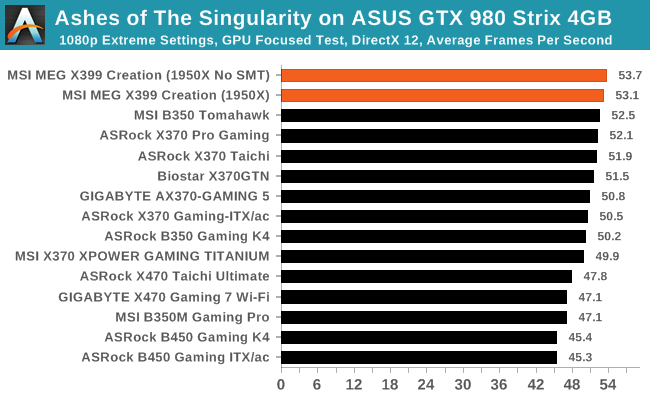
Rise Of The Tomb Raider
Rise of the Tomb Raider is a third-person action-adventure game that features similar gameplay found in 2013's Tomb Raider. Players control Lara Croft through various environments, battling enemies, and completing puzzle platforming sections, while using improvised weapons and gadgets in order to progress through the story.
One of the unique aspects of this benchmark is that it’s actually the average of 3 sub-benchmarks that fly through different environments, which keeps the benchmark from being too weighted towards a GPU’s performance characteristics under any one scene.
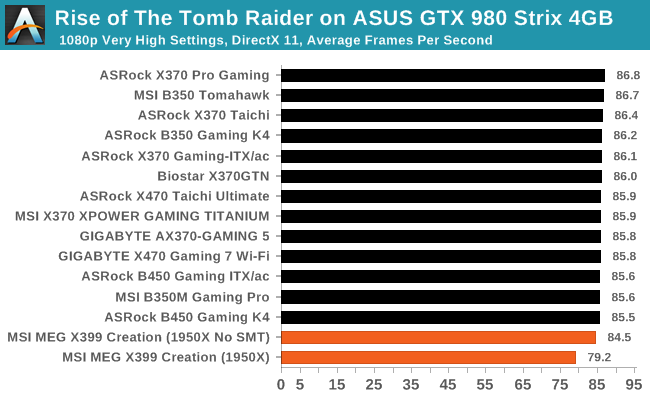
Thief
Thief has been a long-standing title in PC gamers hearts since the introduction of the very first iteration which was released back in 1998 (Thief: The Dark Project). Thief as it is simply known rebooted the long-standing series and renowned publisher Square Enix took over the task from where Eidos Interactive left off back in 2004. The game itself utilises the fluid Unreal Engine 3 engine and is known for optimised and improved destructible environments, large crowd simulation and soft body dynamics.
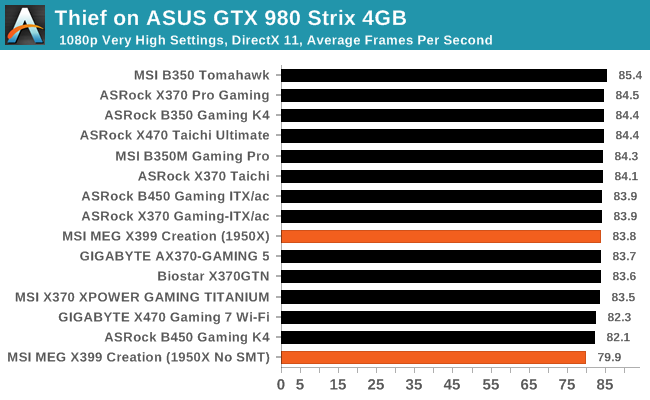
Total War: WARHAMMER
Not only is the Total War franchise one of the most popular real-time tactical strategy titles of all time, but Sega delve into multiple worlds such as the Roman Empire, Napoleonic era and even Attila the Hun, but more recently they nosedived into the world of Games Workshop via the WARHAMMER series. Developers Creative Assembly have used their latest RTS battle title with the much talked about DirectX 12 API so that this title can benefit from all the associated features that comes with it. The game itself is very CPU intensive and is capable of pushing any top end system to their limits.
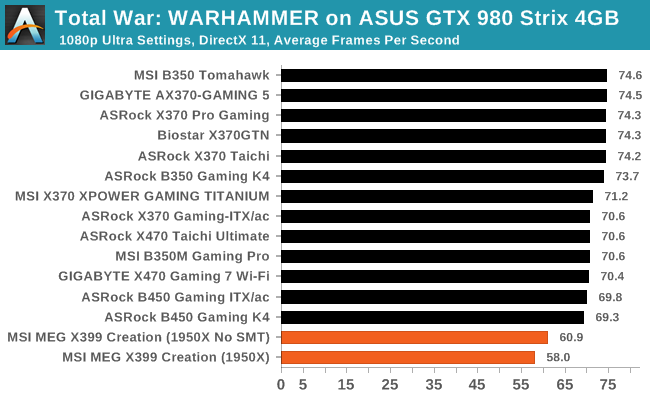
Overclocking
Experience with MSI MEG X399 Creation
While the MSI MEG X399 Creation is primarily marketed towards content creators and gamers looking for a rather comprehensive and feature-laden board as a foundation to build upon, the board does have some appeal to overclockers as well. The board has a basic overclockers toolkit which consists of a reset and power button, as well as MSI’s Game Boost automatic OC dial. Given that the board does feature a 19-phase power delivery split into sixteen phases for the CPU (using doublers running at 8+0) and 3 dedicated phases for the memory, the board could be suitable for the more extreme overclockers. All that aside, overclocking on the X399 Creation is made easy thanks to the user-friendly and highly intuitive MSI Click BIOS 5. All the relevant settings overclocking settings are there within the BIOS and although alternatives are more suitable for the more fervent such as the ASUS X399 ROG Zenith Extreme, the MSI MEG X399 Creation is certainly highly capable of pushing our Threadripper 1950X to its limit.
Overclocking a Ryzen Threadripper 1950X processor on this board is likely to max out the silicon and our cooling capabilities long before the board starts to show its limitations. Increasing the CPU core voltage as it does increases the power consumption, and in the case of a processor such as the Ryzen Threadripper 1950X, power draw can be essentially doubled.
Methodology
Our standard overclocking methodology is as follows. We select the automatic overclock options and test for stability with POV-Ray and OCCT to simulate high-end workloads. These stability tests aim to catch any immediate causes for memory or CPU errors.
For manual overclocks, based on the information gathered from previous testing, starts off at a nominal voltage and CPU multiplier, and the multiplier is increased until the stability tests are failed. The CPU voltage is increased gradually until the stability tests are passed, and the process repeated until the motherboard reduces the multiplier automatically (due to safety protocol) or the CPU temperature reaches a stupidly high level (100ºC+). Our test bed is not in a case, which should push overclocks higher with fresher (cooler) air.
Overclocking Results
The MSI MEG X399 Creation is rather conservative with core voltage at default with a reported CPU core voltage of 1.176 V at full load. I was surprised to see that when using the Game Boost automatic overclocking function that MSI actually used more modest core voltages within their setting profiles, as usually vendors tend to overvolt massively. Maybe the timid core voltages are a consequence of the increased power draw on a 16-core/32-thread powerhouse such as the 1950X, and MSI didn’t want to over-encumber the boards circuitry unnecessarily; whereas on a more modest desktop platform such as X470, where it matters less in comparison to a platform such as X399. It is pleasant to see that MSI has taken measures to remain controlled in the way it has applied its Game Boost settings and hopefully, this marks a change from MSI overestimating CPU core voltage by ridiculous numbers on their chipsets as sometimes it’s just a step too far.
Settings-wise the only two overclocking profiles that failed under stability testing came when our Ryzen Threadripper 1950X was set to 4.0 GHz at Game Boost 10, and Game Boost 11 which tried to achieve a more audacious 4.1 GHz. While it is possible to achieve this with a good quality cooler, our 1950X didn’t like the conservative core voltage at 4.0GHz, which when bumped up during manual overclocking actually proved stable.
Our Ryzen Threadripper 1950X sample remained unstable at 4.1 GHz, although it POSTed no problems at all with a CPU core voltage of 1.437 V (it is generally recommended that CPU voltage remains below 1.45 V for longevity reasons). At 4.1 GHz before the system's stability became an issue, our power meter reached a reading of just under 400 W which is a massive increase of just over 50% over what was given at the default stock settings. The performance increase in our PovRay benchmark was gradual with no throttling on our test bench. The one questionable result we did see was on MSI’s Game Boost 4 pre-defined setting (x38.5); which we expect is just an anomaly.
MSI MEG X399 Creation Conclusion
The MSI MEG X399 Creation is a high-end motherboard in nearly every sense of the term. MSI has aimed the X399 Creation at content creators and designers, but there is also a clear and understated focus on gaming with elements of suitability for workstation purposes. The MEG X399 Creation is one of the most feature packed and expensive boards from MSI in a long time, and while they have gotten the majority of things right, there are some questionable decisions which do need to be highlighted and touched upon.
The design of the X399 MEG Creation is relatively unique, and although the PCB is black, it has a light grey imprinted patterning which resembles that of sun rays in its straightness emanating from the rear panel heatsink. The rear panel heatsink has the Creation logo etched in with an RGB LED underneath, which mirrors that of an explosion. RGB-wise the board has plenty going for it and has multiple zones as well as a total of three RGB strip headers, with one of them supporting addressable RGB strips. All of these are fully customizable by the comprehensive MSI Mystic Light software, which has to be one of the best around for variance with its umpteen lighting effects.
Other notable elements from a design perspective and storage support include the integrated MSI M.2 Frozr heatsink, which comes in two parts and offers the necessary cooling capacity to keep all three M.2 PCIe 3.0 x4 drives covered if a user so wishes. Two of the M.2 slots have support for up to M.2 2280 drives, while the third slot has support drives up to M.2 22100, with all slots also supporting SATA-based M.2 SSDs. The PCI layout consists of four full-length PCIe 3.0 x16 slots which all have a coating of MSI’s Steel Armor slot protection, and is complimented by a single PCIe 2.0 x1 slot for compatible expansion cards. As the board only supports up to three-way multi graphics card configurations, the fourth full-length slot would seem to be primarily intended for use with the included Xpander-Aero four-way M.2 PCIe expansion card, which in turn is cooled by a graphics card inspired cooler more than capable of dissipating heat from even the hottest of M.2 SSD arrays. The MSI MEG X399 Creation also has eight SATA ports with support for RAID 0, 1, and 10 arrays.
Performance-wise, the X399 Creation does a good job and remains consistent for the most part against the other X399 boards that we have reviewed. But in our system-based performance tests the overall consensus wasn't great, as we had some poor results with system boot times and DPC latency (though none of the X399 boards do especially well here). Otherwise CPU performance was consistent with performance within our DigiCortex neuron simulation benchmark coming in at the highest; a logical consequence of a switch in memory in our X399 test bench.
On paper, the power delivery system is considerably powerful and formidable, exactly what we'd expect for a board demanding a cost of $500. The 19-phase power delivery is split into two sections, 16 for the CPU and 3 for the memory, all of which consist of the Infineon TDA 21472 power stages. Each phase has a dedicated choke and while the CPU section has 16 power stages, the PWM controller is actually running at 8+0, as doublers are being used. Meanwhile each of the memory phases has its own dedicated driver, individual choke and benefits from its own dedicated controller running in a 3+0 configuration. Along those lines, the heatsink integrated onto the power delivery seems more than capable and I don't anticipate there being any issues with any of the current Ryzen Treadripper or new Threadripper 2 processors. The end result then is that overclocking is something this board does quite well, and users looking to run this on sub-zero cooling methods will appreciate the dual 8-pin CPU inputs, which processors such as the new Ryzen Threadripper 2990WX may need when overclocked under load.
Rear panel-wise, the MSI MEG X399 boasts a total of ten USB 3.1 ports, with a Gen 2 Type-C port, a Gen 2 Type-A port, and eight Gen1 Type-A ports. The regularly used Realtek ALC 1220 audio codec powers the five 3.5mm gold plated audio jacks and the single S/PDIF optical output, as well as supporting cases featuring front panel audio capabilities through an internal header.
In terms of networking, MSI has gone with a more premium Intel 9620 Wave 2 capable 802.11ac Wi-Fi card. But they seem to have dropped the ball when it comes to wired networking capability. The X399 Creation does have two LAN ports available – powered by Intel I211-AT Gigabit controllers – but the use of "just" Gigabit controllers is an odd choice. With a focus on professionals and content creators, the MEG X399 Creation should be including 10 GigE ports, especially given the $500 price tag commanded by MSI. Even the ASRock X470 Taichi Ultimate for $200 less managed to include one, and as a result I feel this to be a massive oversight on behalf of MSI here, especially given the benefits this would give to workstation users with 10G internet capabilities. But on the up side at least, there are plenty of PCIe slots and bandwidth to support 10GigE add-in cards.
Overall MSI has done a great job with the MEG X399 Creation, thanks to a mixture of good design choices such as the numerous 4-pin fan headers and the heatsink-covered M.2 slots. The aesthetics are unique and the creative explosion-inspired look with more RGB than you can shake a stick at makes this a desirable offering. However I still believe the lack of 10G LAN to be a massive hindrance on a board which prides itself on being a flagship, especially one priced to match. If MSI had put a little more thought into how they configured the board – favoring premium integrated features over exorbitant add-ons such as the Xpander-Aero M.2 PCIe card – then the MEG X399 Creation could have been the new X399 flagship motherboard that it so much deserved to be.

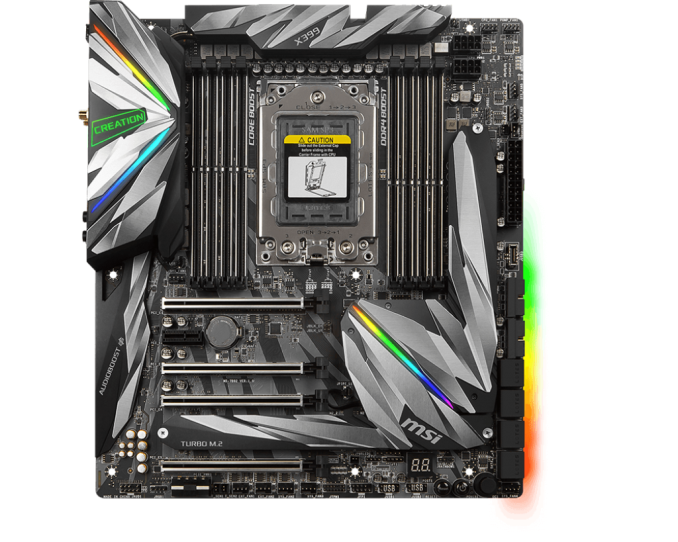

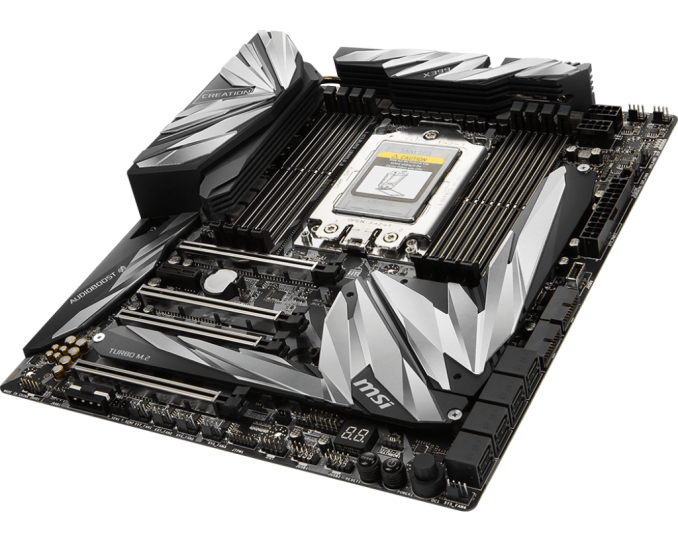
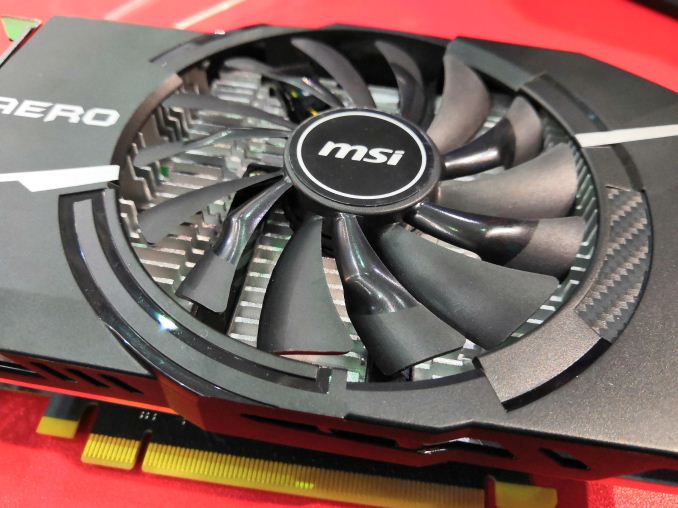
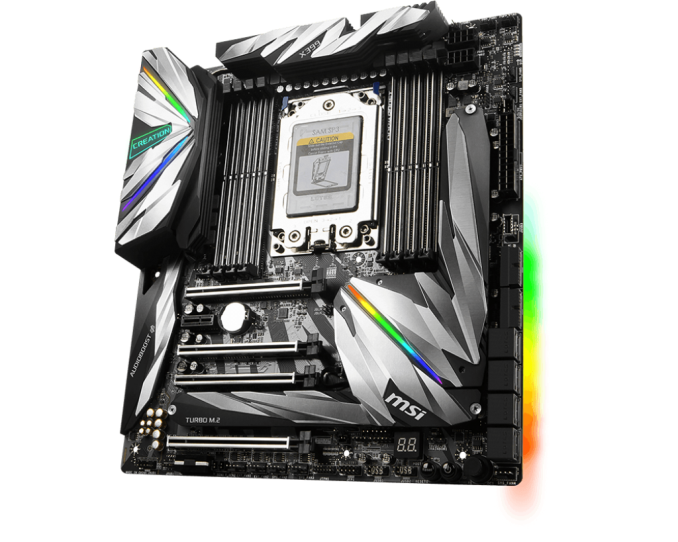
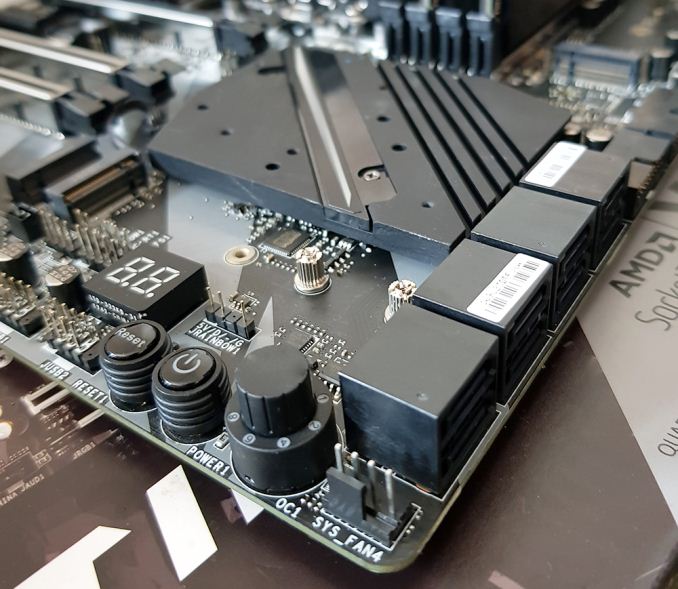
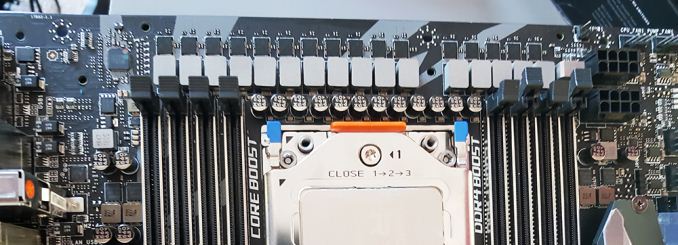
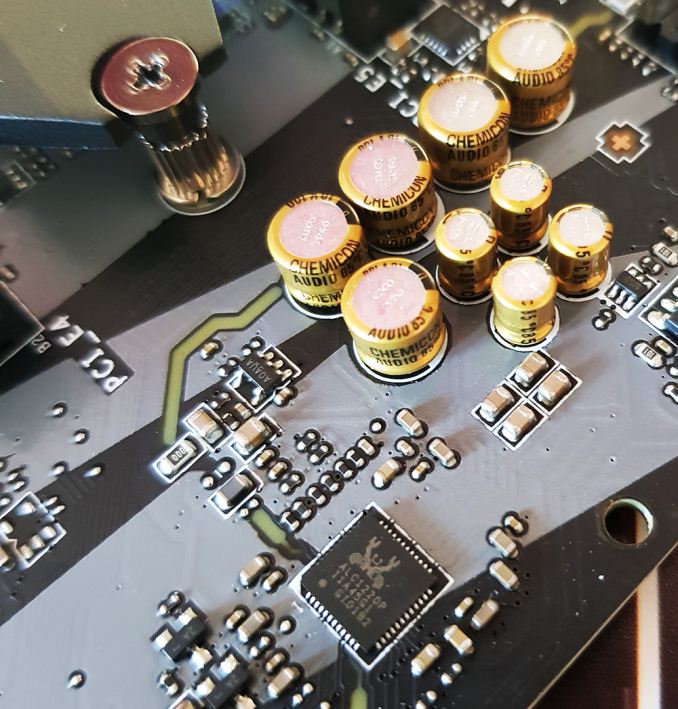
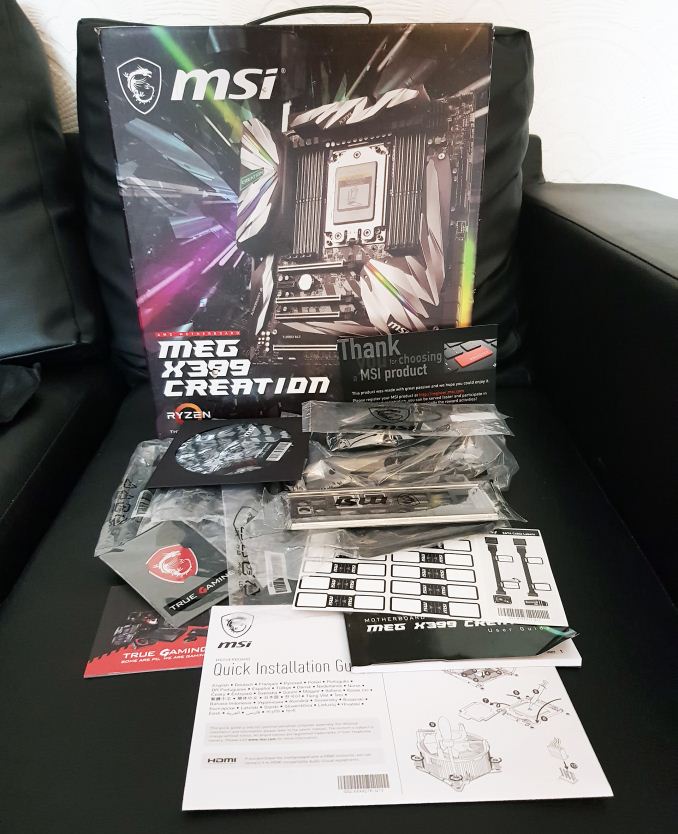
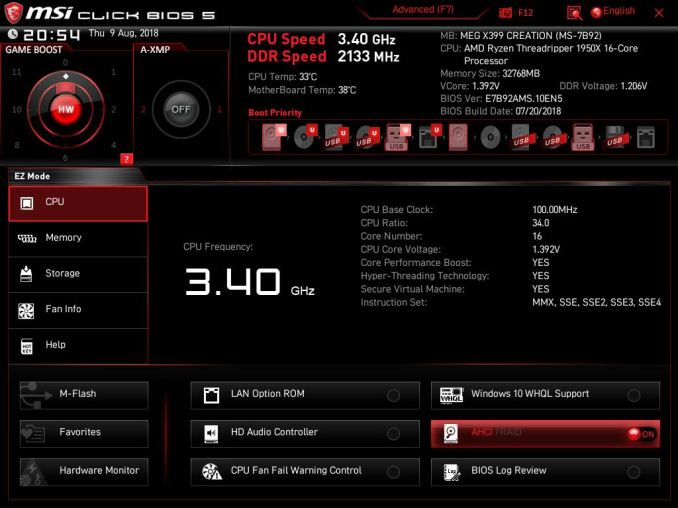
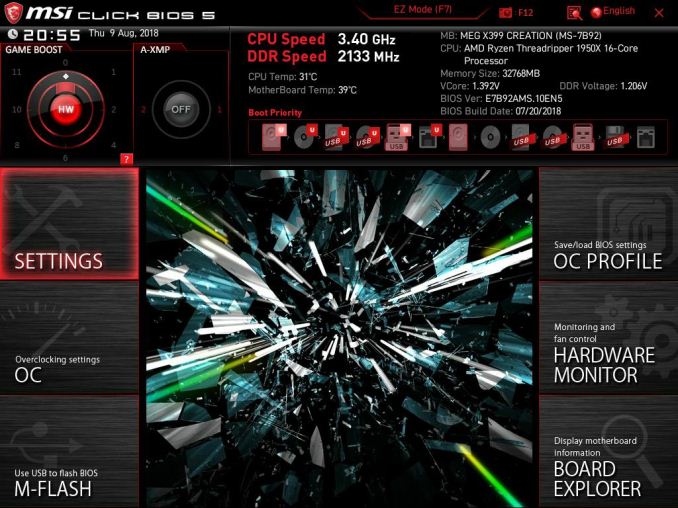
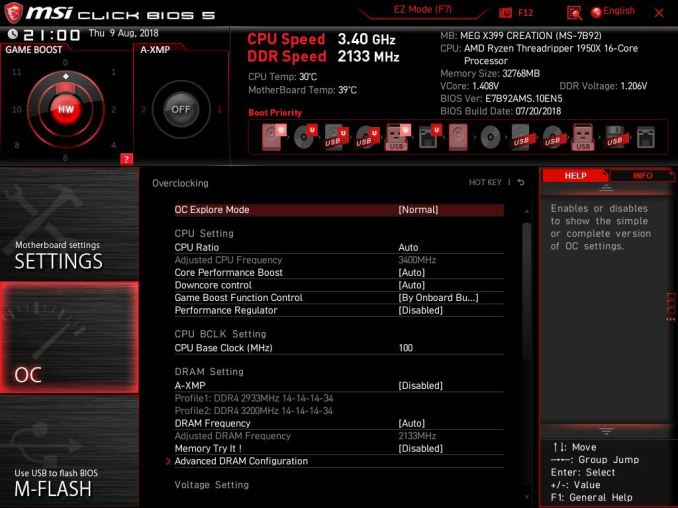
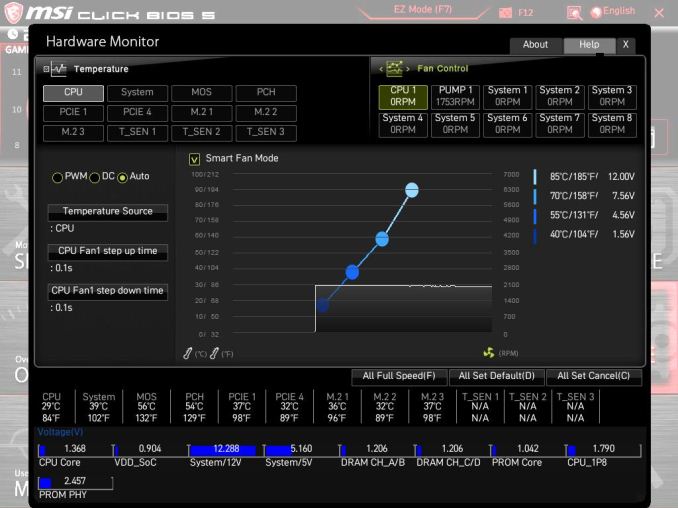
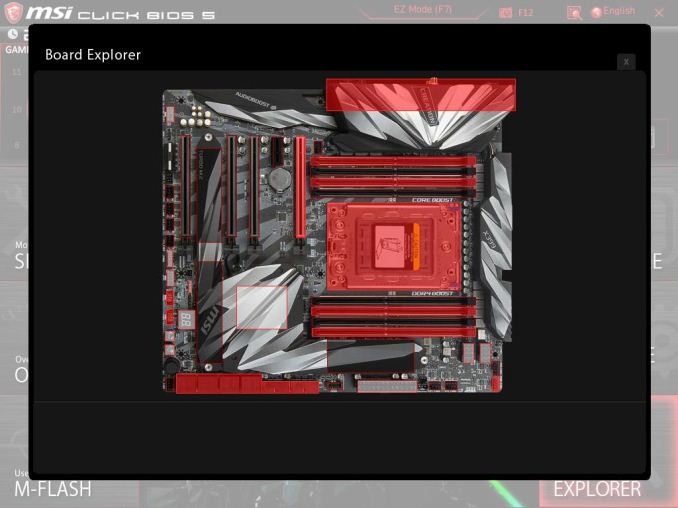
_thumb.jpg)
_thumb.jpg)
_thumb.jpg)
_thumb.jpg)
_thumb.jpg)
_thumb.jpg)
